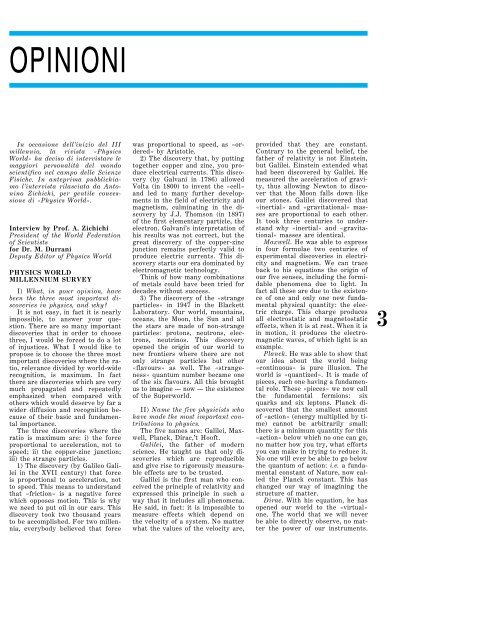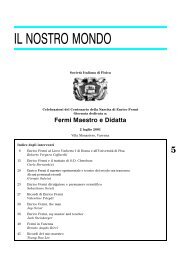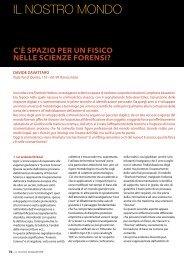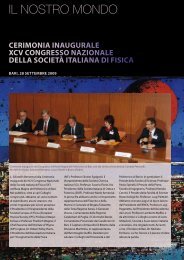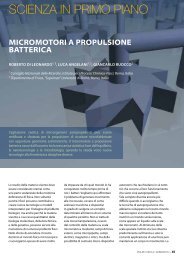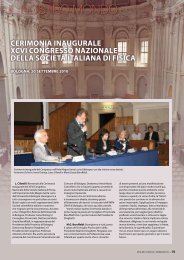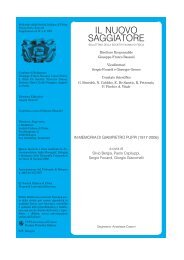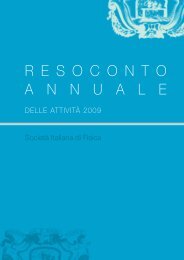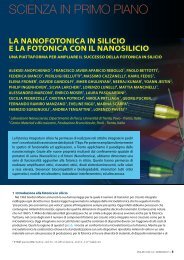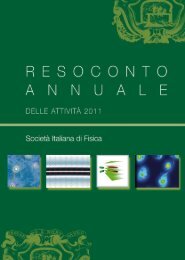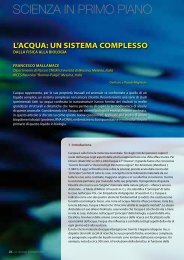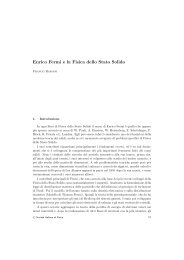IL NUOVO SAGGIATORE - Società Italiana di Fisica - If
IL NUOVO SAGGIATORE - Società Italiana di Fisica - If
IL NUOVO SAGGIATORE - Società Italiana di Fisica - If
Create successful ePaper yourself
Turn your PDF publications into a flip-book with our unique Google optimized e-Paper software.
OPINIONIIn occasione dell’inizio del IIImillennio, la rivista «PhysicsWorld» ha deciso <strong>di</strong> intervistare lemaggiori personalità del mondoscientifico nel campo delle ScienzeFisiche. In anteprima pubblichiamol’intervista rilasciata da AntoninoZichichi, per gentile concessione<strong>di</strong> «Physics World».Interview by Prof. A. ZichichiPresident of the World Federationof Scientistsfor Dr. M. DurraniDeputy E<strong>di</strong>tor of Physics WorldPHYSICS WORLDM<strong>IL</strong>LENNIUM SURVEYI) What, in your opinion, havebeen the three most important <strong>di</strong>scoveriesin physics, and why?It is not easy, in fact it is nearlyimpossible, to answer your question.There are so many important<strong>di</strong>scoveries that in order to choosethree, I would be forced to do a lotof injustices. What I would like topropose is to choose the three mostimportant <strong>di</strong>scoveries where the ratio,relevance <strong>di</strong>vided by world-widerecognition, is maximum. In factthere are <strong>di</strong>scoveries which are verymuch propagated and repeatedlyemphasized when compared withothers which would deserve by far awider <strong>di</strong>ffusion and recognition becauseof their basic and fundamentalimportance.The three <strong>di</strong>scoveries where theratio is maximum are: i) the forceproportional to acceleration, not tospeed; ii) the copper-zinc junction;iii) the strange particles.1) The <strong>di</strong>scovery (by Galileo Galileiin the XVII century) that forceis proportional to acceleration, notto speed. This means to understandthat «friction» is a negative forcewhich opposes motion. This is whywe need to put oil in our cars. This<strong>di</strong>scovery took two thousand yearsto be accomplished. For two millennia,everybody believed that forcewas proportional to speed, as «ordered»by Aristotle.2) The <strong>di</strong>scovery that, by puttingtogether copper and zinc, you produceelectrical currents. This <strong>di</strong>scovery(by Galvani in 1786) allowedVolta (in 1800) to invent the «cell»and led to many further developmentsin the field of electricity andmagnetism, culminating in the <strong>di</strong>scoveryby J.J. Thomson (in 1897)of the first elementary particle, theelectron. Galvani’s interpretation ofhis results was not correct, but thegreat <strong>di</strong>scovery of the copper-zincjunction remains perfectly valid toproduce electric currents. This <strong>di</strong>scoverystarts our era dominated byelectromagnetic technology.Think of how many combinationsof metals could have been tried fordecades without success.3) The <strong>di</strong>scovery of the «strangeparticles» in 1947 in the BlackettLaboratory. Our world, mountains,oceans, the Moon, the Sun and allthe stars are made of non-strangeparticles: protons, neutrons, electrons,neutrinos. This <strong>di</strong>scoveryopened the origin of our world tonew frontiers where there are notonly strange particles but other«flavours» as well. The «strangeness»quantum number became oneof the six flavours. All this broughtus to imagine –– now –– the existenceof the Superworld.II) Name the five physicists whohave made the most important contributionsto physics.The five names are: Galilei, Maxwell,Planck, Dirac,’t Hooft.Galilei, the father of modernscience. He taught us that only <strong>di</strong>scoverieswhich are reproducibleand give rise to rigorously measurableeffects are to be trusted.Galilei is the first man who conceivedthe principle of relativity andexpressed this principle in such away that it includes all phenomena.He said, in fact: it is impossible tomeasure effects which depend onthe velocity of a system. No matterwhat the values of the velocity are,provided that they are constant.Contrary to the general belief, thefather of relativity is not Einstein,but Galilei. Einstein extended whathad been <strong>di</strong>scovered by Galilei. Hemeasured the acceleration of gravity,thus allowing Newton to <strong>di</strong>scoverthat the Moon falls down likeour stones. Galilei <strong>di</strong>scovered that«inertial» and «gravitational» massesare proportional to each other.It took three centuries to understandwhy «inertial» and «gravitational»masses are identical.Maxwell. He was able to expressin four formulae two centuries ofexperimental <strong>di</strong>scoveries in electricityand magnetism. We can traceback to his equations the origin ofour five senses, inclu<strong>di</strong>ng the formidablephenomena due to light. Infact all these are due to the existenceof one and only one new fundamentalphysical quantity: the electriccharge. This charge producesall electrostatic and magnetostaticeffects, when it is at rest. When it isin motion, it produces the electromagneticwaves, of which light is anexample.Planck. He was able to show thatour idea about the world being«continuous» is pure illusion. Theworld is «quantized». It is made ofpieces, each one having a fundamentalrole. These «pieces» we now callthe fundamental fermions: sixquarks and six leptons. Planck <strong>di</strong>scoveredthat the smallest amountof «action» (energy multiplied by time)cannot be arbitrarily small:there is a minimum quantity for this«action» below which no one can go,no matter how you try, what effortsyou can make in trying to reduce it.No one will ever be able to go belowthe quantum of action: i.e. a fundamentalconstant of Nature, now calledthe Planck constant. This haschanged our way of imagining thestructure of matter.Dirac. With his equation, he hasopened our world to the «virtual»one. The world that we will neverbe able to <strong>di</strong>rectly observe, no matterthe power of our instruments.3


